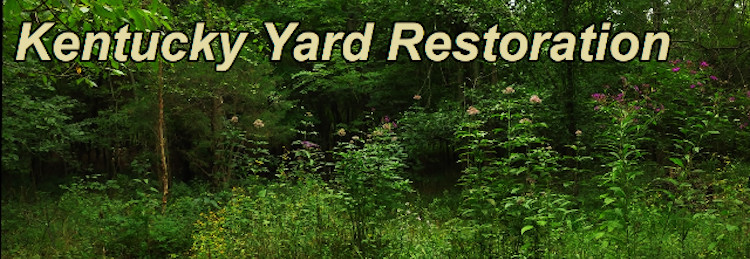
By Beate Popkin, President, Wild Ones: Native Plants/Natural Landscapes, Lexington Chapter
In 2015, I began to visit Hisle Park in northeast Fayette County on a regular basis. Every time I drove out there, I was mystified by a property on Briar Hill Road where a very large number of young oaks grew in a dense plantation. In the winter and early spring, a house became visible at the end of a long curving driveway. What contrast to the surrounding pastures where horses grazed in expansive fields! Who created this planting and for what purpose?
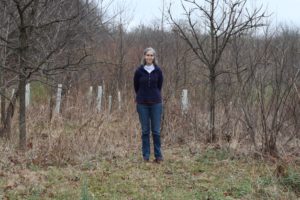
Then, in the summer of 2020, I met Ann Whitney Garner, the owner, and she invited me to her farm. On that first visit I drove through the opened gate with intense expectation and followed the driveway in awe at the extent of the plantation. The trees growing in rows stretched almost up to the residence. Ann Whitney showed me the garden, chicken coop, barn and small tree nursery behind the house, then took me through a small natural woodland to a substantial creek, David’s Branch, that forms the rear border of the property.
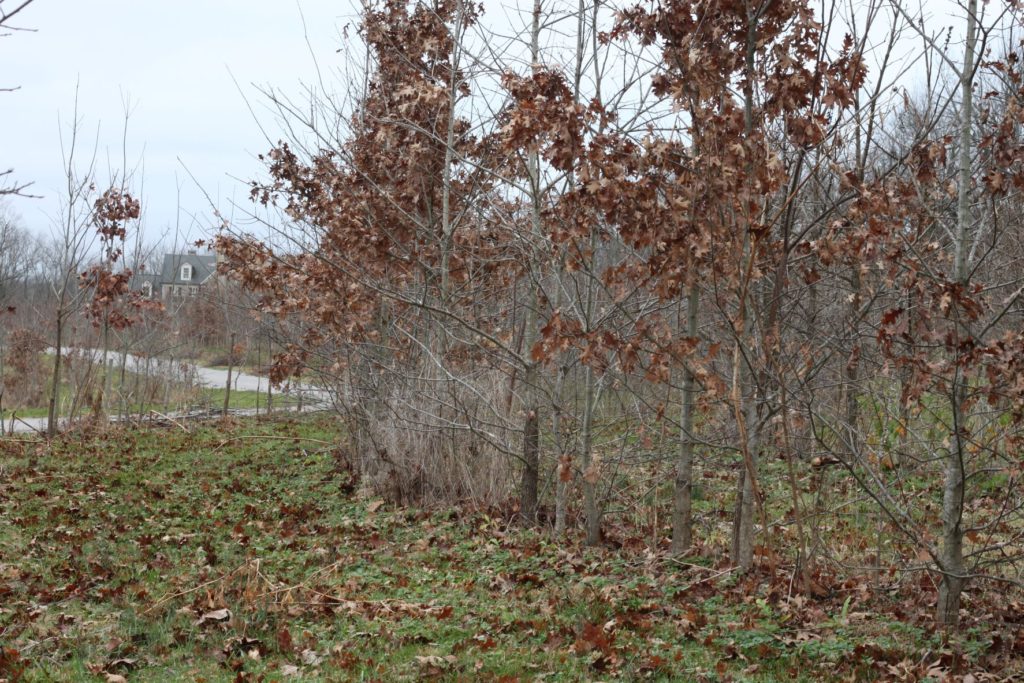
She and her husband Allen Garner bought this 20-acre lot in 2006. In 2008, they moved with their three school-aged children into their newly constructed home and engaged a landscape contractor to design and install the plantings typical of Bluegrass residences: many boxwoods, cherry laurels, which are now dead, and more than 500 liriope plants, which Ann Whitney has since dug up and discarded.
The Garners do not come from farm backgrounds, yet they wanted to use their land for some kind of agrarian activity that would reduce the amount of mowing on their empty space. They knew that they did not want horses. They considered a vineyard but found out that their land was too alkaline. They played with the idea of growing corn or organic tobacco but had to acknowledge that they would get no return on their investment of money and effort.
They knew that they cared about nature, and Ann Whitney anticipated the moment when her children would go to high school and then college, and she looked forward to a new kind of work. She couldn’t exactly define what it would be, but she wanted to work on her property. In 2010, she had an epiphany: “Why don’t we grow what’s supposed to be here,” she asked herself and her family. She had walked her property almost daily pondering what she observed: the way bush honeysuckle and winter creeper intruding from the perimeter suppressed the regeneration of plants, and the possibilities offered by the large expanse of open space. It occurred to her that the property called for trees, because that is what Nature would plant on it. Trees would create wildlife habitat, beauty and—in the very long term—financial value.
The Kentucky Division of Forestry helped her move forward with her project providing several forest management plans, offering tree seedlings for a very reasonable price and eventually loaning her a mechanical tree planter. During the first year she ordered and planted 100 trees: many redbuds, some pecans, sycamores, and bur oaks. Then she put in an order of 300 trees, including many bald cypress for a low-lying area.
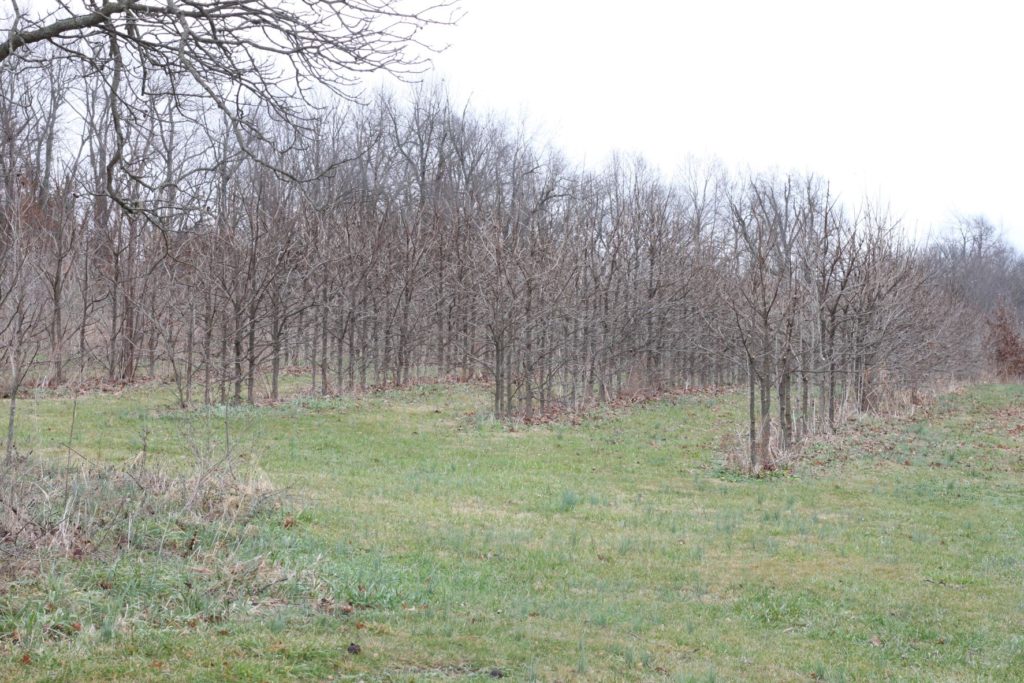
Then, in 2013, the Garners took a big plunge ordering 5,000 oak seedlings, 1,000 each of swamp white, bur, northern red, Shumard and chinquapin oak. They chose oaks knowing that they would be slow-growing and not immediately overwhelm them with labor-intensive management tasks. They also assumed that an investment in oaks can provide a financial return in the distant future when selective harvesting for some kind of a niche market may become feasible. Also, Ann Whitney had taken note of Doug Tallamy’s argument in Bringing Nature Home, that oaks are immensely valuable as habitat trees and a food source for a huge variety of caterpillars thereby sustaining a large bird population.
When they ordered their 5,000 oaks, the Garners knew from experience that this number could not be planted with shovels, and that is where the mechanical tree planter came in. Hitched to a tractor, it carves grooves in the ground where individual workers riding on the machine place bare root plants at regular intervals. The entire Garner family participated in planting the oaks which turned into a surprisingly efficient and gratifying project.
Encouraged by their success with the oaks, they embarked on their last large planting endeavor two years later by installing 1,000 tulip poplars in a remaining empty space behind the house. Ann Whitney had observed how fast the poplars grew and decided she wanted to speed along the development of a canopy cover on at least part of the property.
With the restoration of the Bluegrass underway, birds became more abundant, and the soil began to absorb water more readily due to the expanding roots that channel it into the ground. But with the planting done, new questions arose: How does one live as a good steward on a property into which one has invested so much time, energy and money? Does the property lend itself to other uses that are still compatible with the goal of sustaining Nature?
In 2019, Ann Whitney started a tree nursery. Having handled thousands of tree seedlings over almost ten years, she concluded: “I can do this myself.” She studied up on propagation techniques and collected seeds of native trees growing in the Bluegrass.
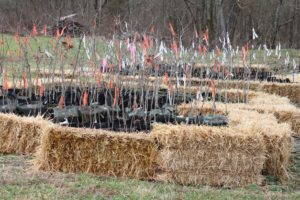
She wants to inspire other property owners to follow her example restoring the Bluegrass, creating habitat for wildlife and helping the soil heal. She would like to make resources available to help them get started, and first and foremost among these are young trees. At this point her nursery has a number of native species available in 3- and 5-gallon containers. Her website is at https://www.fieldstoforest.com/.
Many landowners in Kentucky live on properties that they do not imagine ever returning to agricultural use. In Fayette County a single residential house can be built on 20-acre lots outside the urban service boundary with the official explanation that it serves agricultural activities, even though there is rarely any evidence of them. Instead, one drives past large lots with a house in the distance, possibly a few trees here and there, but otherwise with the ground covered in turf grass subject to a relentless mowing regime. It doesn’t have to be this way.
Ann Whitney Garner let her land speak to her. She walked on it and she worked on it. And she reflected on what she saw. She considered agricultural ventures. She became interested in ecology reading about plants and the animals they sustain. She sought professional advice and consulted with local arborists and biologists. Now, more than ten years after the big decision was made to reforest her land, she says: “I just know this is what we are supposed to do on this kind of property.”
Plants Mentioned in this Article
Buxus sempervirens – boxwood
Carya illinoinensis – pecan
Cercis canadensis – redbud
Euonymus fortunei – wintercreeper
Liriodendron tulipifera – tulip poplar
Liriope muscari
Lonicera maackii – bush honeysuckle
Platanus occidentalis – sycamore
Prunus laurocerasus – cherry laurel
Quercus bicolor – swamp white oak
Quercus macrocarpa – bur oak
Quercus muehlenbergii – chinquapin oak
Quercus rubra – northern red oak
Quercus shumardii – shumard oak
Taxodium distichum – bald cypress
Beate Popkin is the owner of Living Gardens, a Landscape Consulting business in central Kentucky. She is also the President of the Lexington Chapter of Wild Ones, Native Plants/Natural Landscapes, an environmental advocacy group. She lives in Lexington where she manages a number of native plant gardens on public and private ground.
